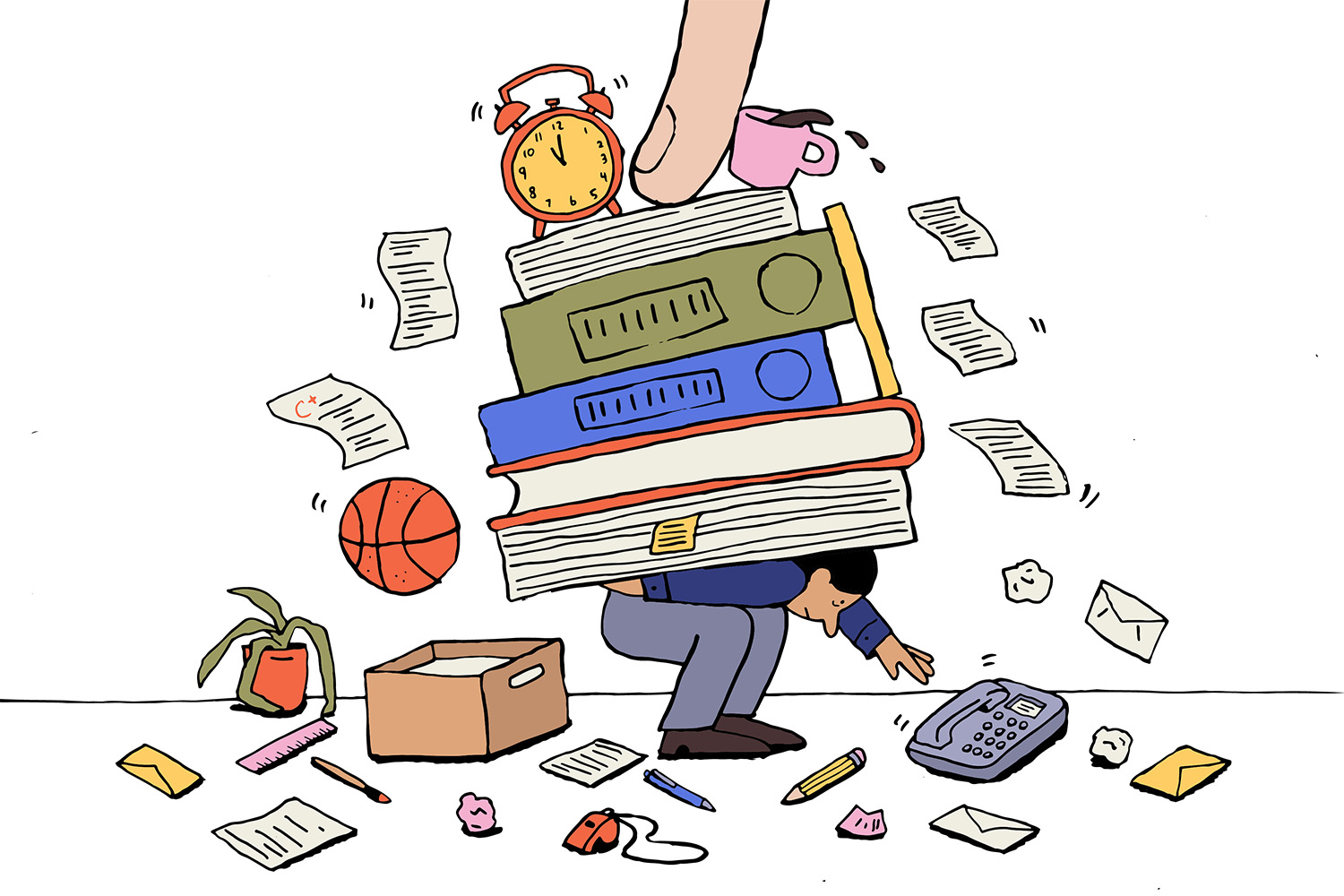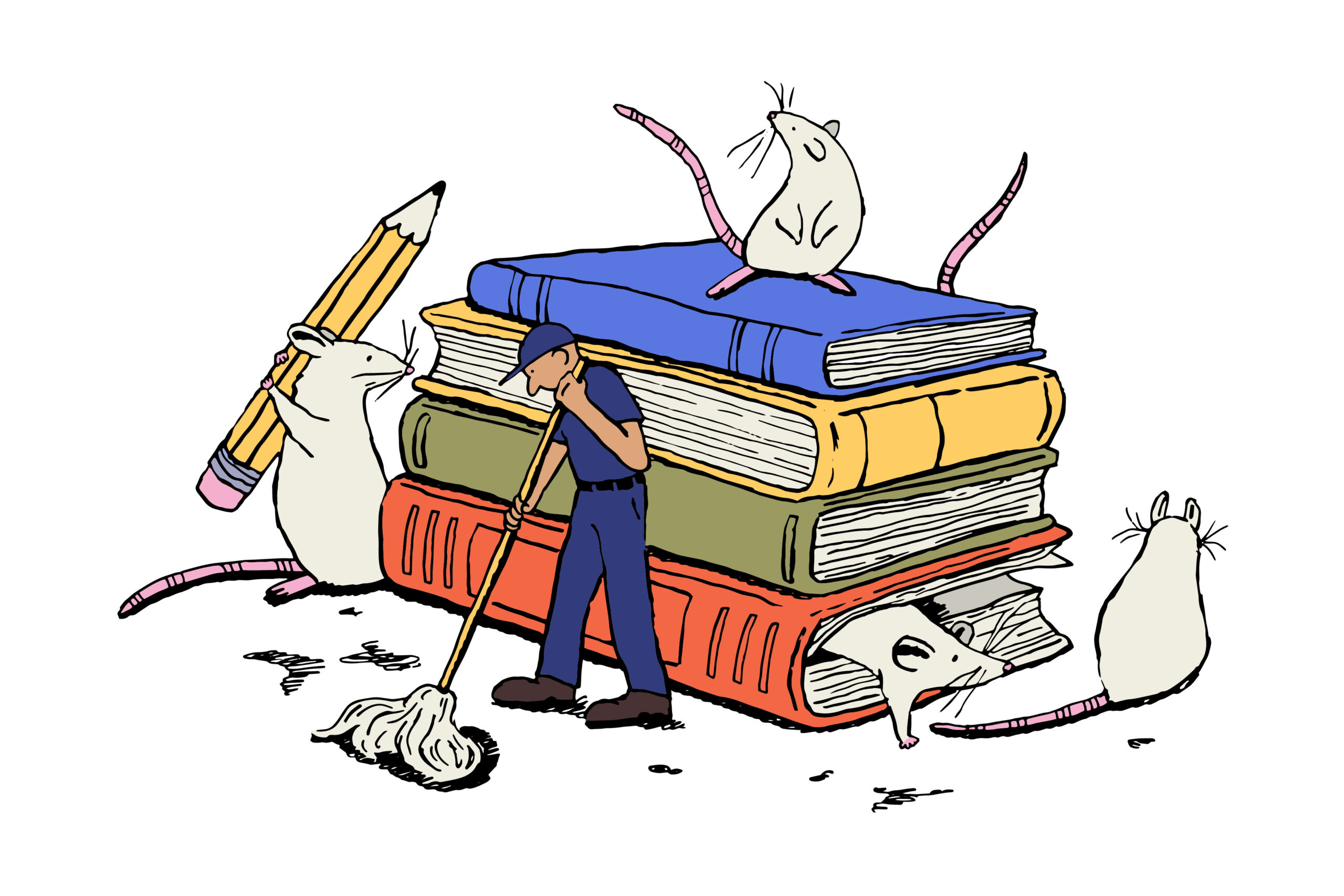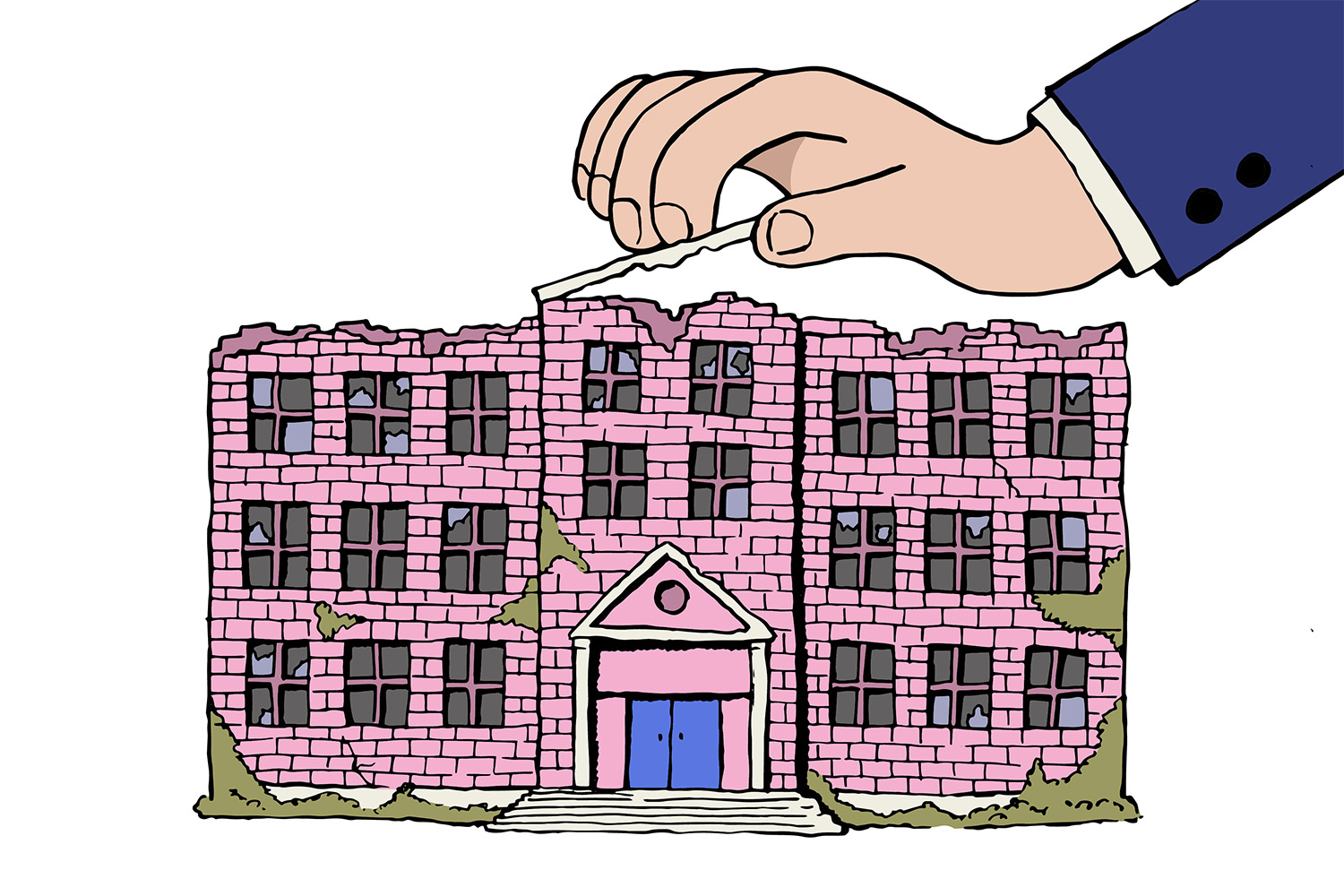

Marie Smith sat next to the boy, stunned by what he wrote.
The boy had already spent a full year with Smith, a veteran educational assistant with the Toronto District School Board (TDSB). Smith works with a special education teacher in an intensive support program, or special education class, of 12 students between grades one and three with mild intellectual disabilities.
Amid the daily chaos of the classroom, the boy was generally quiet and kept to himself. But he was also quick to explode, physically striking out at anything or anyone near him if he heard a loud noise like a sneeze. He was considered non-verbal, meaning he didn’t express himself through speech. And like some of his classmates, he wasn’t yet using the toilet on his own.
So that day when Smith had a rare moment to sit down with him and explain that “E” was for “elephant,” she was shocked when he responded by writing out the word “elephant.”
She tried again.
“‘E’ as in ‘envelope,’” she said.
With his pencil in hand, he wrote “envelope.”
“‘E’ as in ‘electricity,’” she said.
Again, he wrote out the entire word.
“He was absolutely brilliant, and we didn’t even know it,” said Smith, who is using a pseudonym because she was not authorized by the TDSB to speak with the media. “Nobody ever had time to sit with him and learn.”
As amazed as she was, the belated discovery of her young student’s abilities also felt deflating to Smith. It was a clear sign she was no longer doing the job she’d signed up for. She was now spending most of her time simply trying to make sure everyone got through the day instead of assisting students with their learning.
In her 25 years on the job, she has noticed a dramatic increase in the proportion of students placed in her class who need high levels of assistance, yet the school system’s ability to serve them has not kept up. There’s a huge demand for the school board’s professionals and paraprofessionals, like speech-language pathologists and physiotherapists, she said. But they only visit Smith’s school “once in a blue moon”—that is, if they visit at all. (She hasn’t seen an occupational therapist come in years.) And instead of actually delivering therapy, these experts tend to merely observe students and offer their recommendations, adding to the list of things Smith doesn’t have time to do.
More of her students these days wear diapers, but there are no changing stations—not even a gym mat, which means she changes them while they stand next to a sink in the washroom. And while she used to take some of her students to join the school’s mainstream classes for gym, art, or music to try to integrate them with the rest of the student body, that has now become impossible, since at any time, one of them may need a diaper change, while another is lashing out and yet another is trying to run away.
“I’m an educational assistant, so I’m there to assist educationally, but I’m not even doing that any more,” Smith said.
Join the thousands of Torontonians who've signed up for our free newsletter and get award-winning local journalism delivered to your inbox.
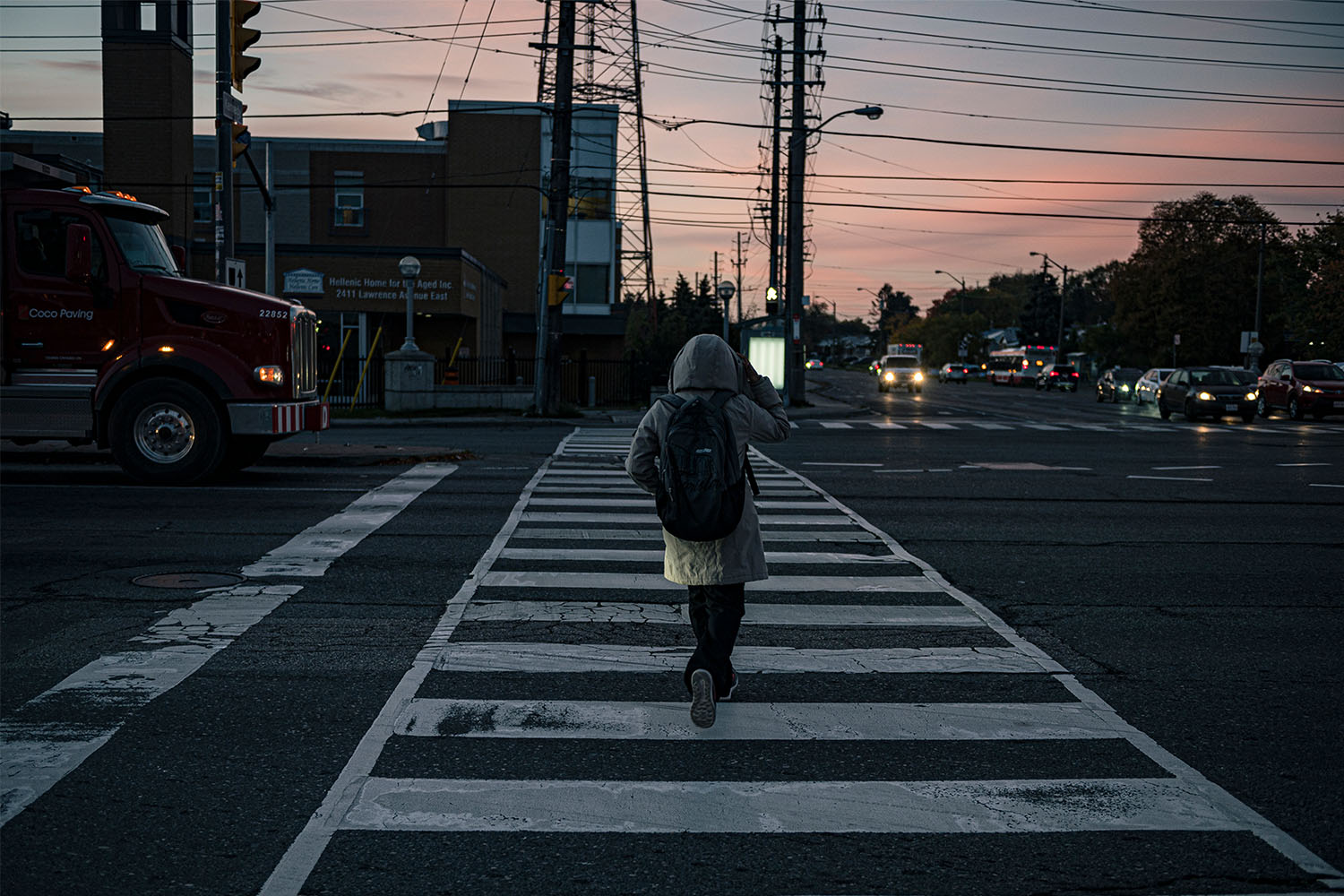
In a public education system that is suffering from decades of underfunding, it’s the students receiving special education who feel it most. That broad designation includes students with disabilities, those with a wide range of developmental, learning, and behavioural conditions, and those who struggle in school for various reasons but do not have a diagnosis. Special education students are often the most vulnerable, the kids who would benefit most from educational intervention. They’re the proverbial canaries in the coal mine: the quality of their school experience is an indicator of how well the education system is working as a whole. When students get the attention, resources, and opportunities they need, they’re less prone to outbursts, less likely to become frustrated, bored, or overwhelmed, and at lower risk of acting out violently or trying to flee. Teachers have more time and energy for the entire class, and everyone is safer and better off.
Yet all too often, according to TDSB educators and parents, that’s not happening. They say schools are woefully underfunded and understaffed, without enough caring adults to keep students safe, never mind help them flourish. Under the guise of “inclusion”—that is, the aim of having schools and classrooms accommodate all students, instead of segregating them by their ability—many students with disabilities are essentially “abandoned” in mainstream classrooms, without appropriate support, they say.
Meanwhile, disability rights advocates say the very foundations of the public education system are flawed, as it treats students with disabilities as an afterthought. The answer isn’t necessarily more money or more staff, some advocates say, but a long-overdue paradigm shift that eliminates segregated learning, tears down barriers for students with disabilities, and requires teachers to teach to all students.
While opinions differ about what the solutions are—whether it’s increased funding or an overhaul in pedagogy, or both—the consensus is that special education is in a state of crisis, currently serving neither the students it’s meant to serve, nor anyone else. And one thing is clear: there’s no fixing the broader public education system so long as students with disabilities and other special education needs are left behind.
“People who are in their 20s and 30s and 40s right now kind of think of school as the same as it was when they were kids. [But] the support and the safety nets that we had growing up …are not there now in the same way,” said Alison Attanasio, a parent organizer with the grassroots Toronto Schools Caregiver Coalition, who has a child with attention deficit hyperactivity disorder (ADHD) in the TDSB. However, she said, for families with children whose learning needs aren’t being met and for educators with an insider view of what’s happening in schools, the inadequacies are obvious.
“I don’t think most parents understand how bad it is,” Attanasio said, adding she’s concerned the consequences of inaction will be long-lasting. “On a societal level, I think this is really going to impact this generation of Torontonians and the economic and social health of our city.”
Roughly one in six students in the TDSB receives some level of special education, which can mean certain accommodations in a regular classroom, instruction in a special education class within a mainstream school like Smith’s, or a placement in one of the board’s 12 self-contained special education schools.
According to the TDSB’s 2024 Financial Facts report on its revenue and expenditure trends, there were an estimated 41,549 students receiving special education in 2023-24, or just under 18 percent of the board’s nearly quarter of a million students. Nearly half were identified as having a so-called “exceptionality,” including autism, behavioural challenges, blindness and low vision, language impairment, and giftedness. The formal process of identifying students and placing them into special education programs is done by members of a school board committee, called an identification, placement and review committee (IPRC).
The total number of students receiving special education at the TDSB has actually declined by 14 percent from 2019-20, though it’s not clear why. The TDSB said the decline has been relatively similar to an overall drop in student enrolment. The total number of kids in Toronto has fallen, as young families migrate to more affordable areas beyond the city. But there may be other reasons, too. Parents who can afford to do so may be pulling their children out of the public education system in favour of private schools. And some advocates say they suspect the decline in numbers simply means many students have disabilities or conditions that are not identified, and therefore they’re left out of the count.
As special education enrolment has gone down, there’s been a reduction in special education teaching staff within the past five years as well, by 8.4 percent in elementary and 3.5 percent in secondary grades. However, these shrinking numbers don’t capture the extent of students’ needs. Nor do they capture a multitude of other factors, including the high rates of burnout among educators; the decline in other staff members, like office support staff and lunch supervisors, to whom students can turn for help; the woefully insufficient professional and paraprofessional support; and the poorly tracked frequency at which students are excluded or sent home early when schools can’t handle or accommodate them. All are issues that parents, educators, and advocates described in interviews with The Local.
“I don’t think most parents understand how bad it is”
Some of the trends occurring at the TDSB mirror what’s happening at other school boards in the province. A 2023-24 survey by the charitable organization People for Education found the ratio of special education students to special education teachers at public schools across Ontario has remained relatively unchanged over the past five years, at 39 students to one teacher in elementary schools and 85 to one in secondary schools. But daily staff shortages, particularly among educational assistants, have become severe. According to the survey, special education teachers often have to fill in for regular classroom teachers and educational assistants, which takes them away from special education students. Nearly half of all elementary and secondary schools reported shortages of educational assistants every day. Tied to these shortages, the survey found 63 percent of elementary school principals and 58 percent of secondary school principals said they had asked parents to keep their child with special education needs home for the day, a steady increase from 48 percent and 40 percent respectively a decade ago.
It’s only relatively recently that schools have been required to serve children with disabilities. In 1980, Ontario’s Ministry of Education introduced Bill 82, which required that all children, including children with disabilities, have access to publicly funded education in the province. Nearly three decades later, in 2009, the province outlined its strategy for equitable and inclusive education, with the stated vision that “every student is supported and inspired to succeed in a culture of high expectations for learning.”
At a special education advisory committee meeting earlier this spring, then-TDSB chair Rachel Chernos Lin acknowledged the board needs to do better to live up to its commitment to inclusion.
But, she said, “in a time of scarcity, it’s a challenge. And that is unfortunately where we’ve been for several years.”
In early November, the TDSB’s Special Education Advisory Committee, composed of trustees and representatives of local organizations with an interest in special education, held a special town hall meeting to hear from parents. Dozens showed up and took turns speaking about how years of scarcity have affected their children. One after another, they expressed frustration, fear, and desperation.
One parent choked up while describing her family’s struggle to get her child a placement in a special education kindergarten class. The child, who had autism spectrum disorder, couldn’t cope in a mainstream junior kindergarten, and attended class only a few hours a day, crying constantly. School should be a positive experience for children, the parent said. Instead, “it’s been an absolute nightmare for my family.”
At least two other parents had the reverse problem: their children were automatically directed to segregated special education classes or schools, based solely on school officials’ assumptions about the children’s diagnoses. They weren’t offered the option of sending their children to a mainstream class, as they’d wished.
Some parents described the onerous process of having to fill out forms year after year for their children’s individual education plans, or IEPs, only to find that the accommodations their children were granted existed only on paper. Their schools didn’t have enough educational assistants or child and youth workers, and teachers lacked the time or know-how to implement those IEPs. Several said their children were frequently sent home early because their schools didn’t have the resources to deal with them. One parent said that while her child was at the TDSB, he ended up barely attending school. And when he did, he wound up watching YouTube in a corner.
Sandra Huh told The Local that her son, Ashton, who is in grade 7, masks the signs of having autism spectrum disorder while he’s at school, in his mainstream classroom. But whenever he gets sensory overload in the noisy environment or has trouble coping with a change in routine, he gets anxious. When that happens, he gets headaches or sick to his stomach, or will cry over things he wouldn’t normally cry about, or feel the need to get away. He once went and hid inside a locker.
Ashton has trusted adults at his school to whom he can turn for help, Huh said. But this fall, cuts to staff meant the loss of a child and youth worker, who wasn’t directly assigned to Ashton but would look out for him and knew every student in the school by name, she said. It also meant the loss of an office administrator, who would regularly call Huh just to touch base or update her if she spotted her son in the hall looking as though he was having a bad time. That office administrator played an integral role in her son’s improved self-confidence and regulation skills, Huh said.
The task of balancing school budgets is done “on the backs of students—and not just special needs students, but all students,” Huh said, noting that in a given class of 30 students, there could be as many as five students who require some degree of extra support. “When you have special needs students that are not being supported properly…no one’s learning.”
A Thousand Cuts
From cuts to caretakers, to overworked school administrators, to a lack of resources for special education, our ongoing series examines how our schools got to where they are now—and what it will take to fix them.
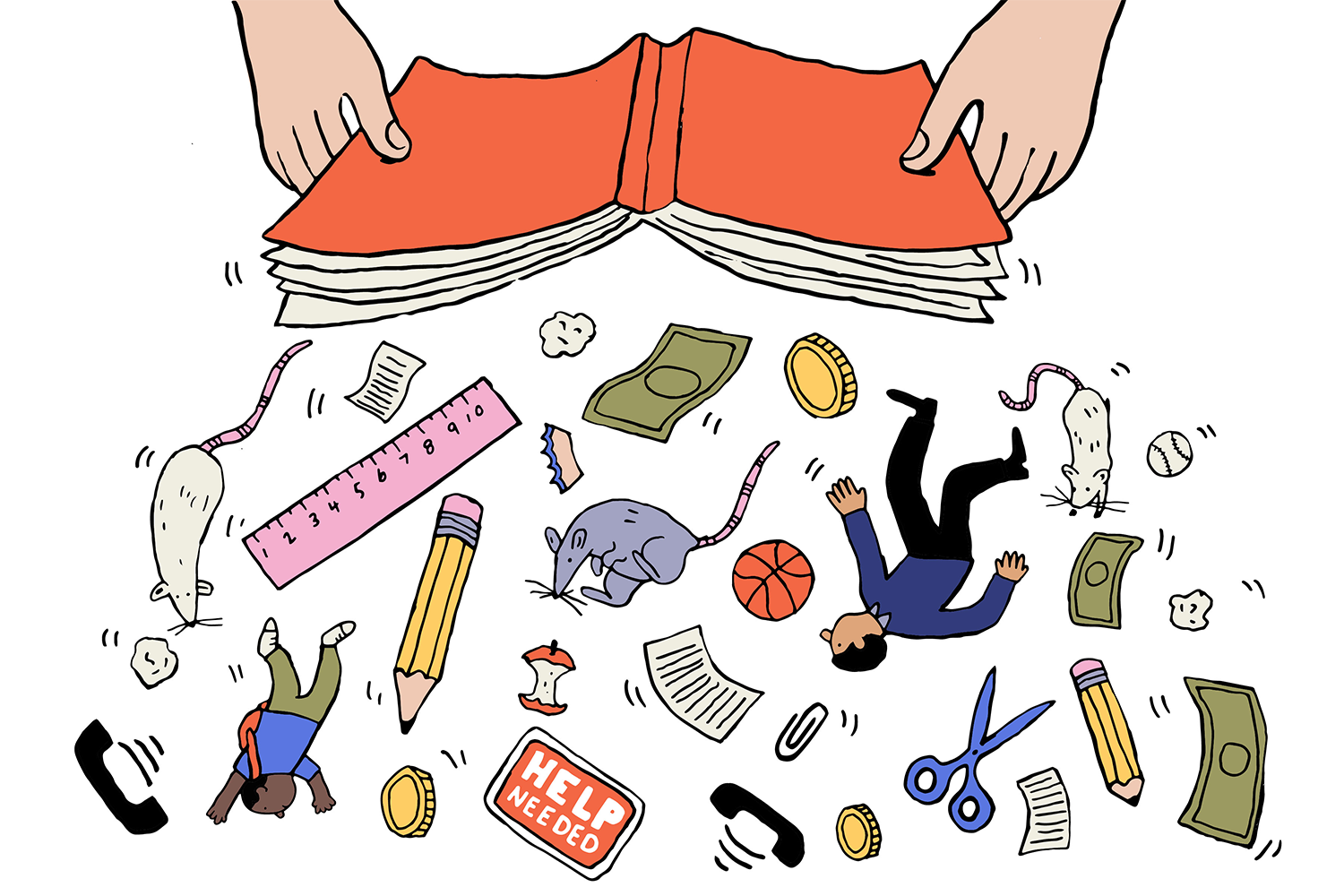
That lack of learning can occur even in a segregated classroom, where everyone has special education needs. Every day, Marie Smith, the veteran educational assistant, helps her class through their routine, which includes a mix of individual and group activities like reading, writing, singing songs, outdoor learning, gym class, recesses, snack times, and a half-hour lunch.
The students benefit from having a predictable schedule, Smith explained. But for her, getting through the day is like running a gauntlet. “This student’s doing this. This student’s doing that, or whatever. There’s a fight here,” she said. “It’s constant: ‘I need to go to the bathroom. I need water. I need this, I need that,’ you know, tapping on you because they’re non-verbal.”
She says she has always tried to find a task, a skill, or a concept that she can work on with her students that can eventually help them when they reach age 21, and age out of the education system. But these days, she finds it hard to do that any more “because all I’m doing is putting out fires.”
What’s changed is not the ratio of 12 students to two adults in the class, she said. Rather, the functioning level of the students assigned to her class has declined. About a decade ago, she would get students who scored in the 9th percentile or below among the student population in tests of their cognitive function. That was eventually changed to the 5th percentile and below, she said, and now it’s the third percentile and below. Students who score above that threshold may either qualify for a different program, or stay in a mainstream class with or without support, she explained.
Smith believes the answer isn’t to bring more adults in, but to reduce the number of students per class. “And they’re telling us that can’t be done because of funding,” she said.
It baffles her to hear announcements from Premier Doug Ford and the Education Ministry, boasting of record-high investments in education. “I don’t know what [Ford]’s talking about, because all we’ve seen is cuts,” she said.
The Ministry of Education did not respond to multiple requests for comment from The Local.
Special education students are often the most vulnerable, the kids who would benefit most from educational intervention. They’re the proverbial canaries in the coal mine
Inadequacies in the funding model pre-date the current government, however. According to a Canadian Centre for Policy Alternatives report by long-time researcher Hugh Mackenzie, a substantial proportion of funding that school boards received for special education in Ontario was previously directly tied to whatever the school boards’ identification, placement and review committees, or IPRCs, determined the programming needs were for students. That changed during the Ontario Liberal government led by Dalton McGuinty in the early 2000s when this funding was frozen. Over time, the proportion of funding for special education was instead determined by a formula based on census data.
As funding became constrained, the role of IPRCs, which is meant to be to figure out what additional supports students require, has become “an elaborate exercise in figuring out how to say ‘no’ to parents,” Mackenzie said in an interview earlier this year. “The IPRC has become the funding police.”
A 2022 report by the Canadian Centre for Policy Alternatives explained that under the current funding formula, there was one speech specialist in 2020 for every 2,370 students, or roughly 0.2 specialists per school, and one professional providing psychological services for every 2,580 students. When it came to attendance counsellors, social service professionals, and child and youth workers, Ontario had the equivalent of about half a staff member per school on average.
Like Smith, staff at other schools said they, too, were overstretched.
Joyce Girard, a special education teacher with a class of 12 students in a mainstream high school, said she similarly felt most of her class time was spent “just keeping everyone safe, keeping everyone fed, going to the bathroom.” That’s no small task. When students become dysregulated—whether it’s because a school lacks air-conditioning on hot days, or because they have trouble adjusting to new faces filling in for staff shortages—it’s not uncommon for them to punch, push, or hit.
Insufficient one-on-one support from child and youth workers, who focus on students’ behaviour, social, and emotional development, is “100 percent” contributing to the violence, said Girard, who is also using a pseudonym because she was not authorized to speak to the media.
The scarcity of social workers—141 of them spread out across the TDSB—also means teachers like Girard take on some of their duties as well. For Girard, that means helping her students’ families beyond the classroom to get them on waitlists, fill out paperwork, and access resources offered by the province, such as autism programs, funding, and respite services. But it’s discouraging work; many of her students come from marginalized communities in the low-income neighbourhood of Rexdale, where such resources are scarce.
“It’s so depressing,” she said.
When they’re not at school, Girard explained, some of her students will stay in their apartments all day, because their parents are afraid of what could happen to them if they venture outside. Some have disabilities that are invisible, so to those who don’t know them, they can look like any other young adult. Their parents aren’t at fault for shutting them in, she said. “It’s because they’re so scared that they’ll run away, or they’ll hurt someone, or they’ll get arrested or shot by the police.”
Beyond the issues of staffing and funding, disability rights advocates have some fundamental disagreements about how students should be taught—about what inclusion should look like, and whether segregated schools and classrooms should play a role.
Since the province introduced a regulation in 1998, school boards are required to consider placing students in regular classes with appropriate special education services before placing them in a special education class. But if it’s determined that a regular class isn’t best for them, some TDSB students may be put in an intensive support program, which include classes specifically for students with autism, who are deaf or hard of hearing, or have developmental, physical, or mild intellectual disabilities. Some of these classes are in the board’s 12 segregated, or self-contained, special education schools, which serve more than 1,100 students.
Some advocates, however, argue that it goes against the idea of inclusive education to teach students with disabilities elsewhere, away from their peers. Marilyn Dolmage, a long-time disability rights advocate and associate with the non-governmental organization Inclusive Education Canada, challenges the necessity of segregated schools and classrooms at all. She points out that unlike the TDSB, many other school boards in the province have closed their segregated special education schools and classes, or never had them in the first place.
One thing is clear: there’s no fixing the broader public education system so long as students with disabilities and other special education needs are left behind.
In her view, underfunding is not the biggest problem when it comes to special education. The bigger issue is how school boards spend the money they receive, she said, explaining there’s a lack of oversight to determine whether the TDSB’s spending actually leads to positive student outcomes.
Placing students in segregated schools, which have far higher per-pupil costs than mainstream schools, “takes kids considered most different out of society for their whole lives. It isolates them,” Dolmage said. “All of the rest of the children in Toronto grow up without knowing them.”
Even the idea that disabled students in mainstream classes need an extra adult with them is “totally wrong,” Dolmage said. It can make the student overly dependent on that adult, and can lead to more behavioural problems, she said, “because no student wants to be joined at the hip with an adult.”
Educators, instead, need to adopt a different model of education where students’ differences aren’t seen as a big deal, Dolmage said. Under such a model, she said, it’s logical to pair a student who can’t read with a student who learns better by reading out loud, and a student who demonstrates their learning through art would create materials for a student who learns from pictures better than words. Offering different ways for students to engage with course material is part of a framework called “universal design for learning,” developed by the U.S. non-profit education and research development organization CAST to design curriculum that can be flexible enough that all students can access it.
“It’s a structural change,” Dolmage said. “We shouldn’t be in 2024 just starting to think about this.”
Nora Green, a member of the non-profit Inclusion Action in Ontario and the TDSB’s Special Education Advisory Committee, agrees that teachers need to be able to teach to all students. They shouldn’t assume, as often happens, that teaching students with disabilities is the job of special education staff, she said. Ensuring that teachers can teach to all won’t solve everything, Green said, explaining she believes there is a real need for additional people to provide things like physical help and coaching in reading for students. “But we don’t even have the foundational belief that we’re responsible for everybody in our class,” she said. “The moment I think that a special education teacher is going to do my job, that’s a problem because that special education teacher is only going to see that kid maybe for a period a day. And what’s happening [in] the other periods?”
Leo Lagnado, a member of the TDSB’s Special Education Advisory Committee and representative for Autism Ontario, holds a different view on segregated schools. For some students with very complex needs, there’s no amount of staffing, universal design for learning, or other approach that would allow them to thrive in a mainstream class, he says, noting students should have access to a range of placement options.
According to Lagnado, severe underfunding over many years and multiple governments has led to an inability to recruit and retain much-needed educational assistants. Underfunding, too, is related to a lack of comprehensive training for teachers and support staff to work with students with complex needs, he added.
What’s happening amid this scarcity, he said, is parents often hear from school officials that their child doesn’t need as many supports as they request, and that if they’re given those supports, it means someone else who needs them more won’t get them. This happens even though school boards have a legal duty to accommodate all students with disabilities and other special learning needs.
The concept of inclusion is often used as a cost-cutting device, and a rationale for closing segregated classrooms, Lagnado said. As a result, he said, “they throw those kids into the mainstream classroom without any supports.”
The frustrating thing is there’s a lack of accountability from both the school boards and the Ministry of Education, which blame each other for failing students, Lagnado said. “The reality is that the problem is in both places in different ways.”
Local Journalism Matters.
We're able to produce impactful, award-winning journalism thanks to the generous support of readers. By supporting The Local, you're contributing to a new kind of journalism—in-depth, non-profit, from corners of Toronto too often overlooked.
SupportSetting aside the neverending clash over funding between school boards and the Ministry and the debate over segregated settings, there are many low-cost and practical measures that could be implemented almost immediately that would go a long way to improve the experiences of students and their families, according to David Lepofsky, chair of the TDSB’s Special Education Advisory Committee. The fact that they aren’t speaks to how students with disabilities and special education needs are not prioritized.
For eight years, Lepofsky said, the advisory committee has been urging the TDSB to provide families with an easy to understand “menu” of the programs, services, and accommodations it offers to students with special education needs. Having this resource, he said, would help families navigate what is currently a confounding system, filled with jargon and confusing acronyms.
For many parents, it’s “brutally difficult” to find out what’s available, where to go, and whom to ask, Lepofsky said. They’re either directed to the TDSB’s website, which is written in technical language that’s difficult to understand, or to school administrators, who are already overburdened and must then individually explain it all to each family.
This basic information is critical for parents to be able to advocate for their children, Lepofsky said. He also noted parents aren’t always clearly informed that they can request a meeting to collaborate on their children’s individual education plans. Yet if school officials go on to develop those plans without parental involvement, they could be discordant with the student’s needs, and could set students even further behind.
“If you make the information available simply, clearly, in plain language, easy to find, it’s gonna save everybody a lot of grief,” he said.
At a board meeting this fall, where Lepofsky made a public appeal for this resource, the board adopted a motion to call on the TDSB director to consider it a priority to “effectively and proactively” inform all parents and guardians of the options available and how to access them. Staff, however, gave no clear indication of when an easy-to-understand “menu” would be made available.
Meanwhile, getting action from the province has also been a struggle. Lepofsky, a retired lawyer who is also chair of the Accessibility for Ontarians with Disabilities Act Alliance, has been pushing for the province to enact an education accessibility standard under the Ontarians with Disabilities Act since 2009. This standard would set out requirements for school boards to ensure the entire school system is accessible—not just buildings, but playgrounds, software, and classroom supports for students with all disabilities. Lepofsky explained that even though all this is required by the Human Rights Code and the Charter of Rights, too often, schools don’t provide them.
He noted he was part of an advisory committee of government-appointed experts that submitted a comprehensive report to the province in January 2022, providing detailed recommendations for developing an education accessibility standard. Nearly three years later, that standard has yet to materialize.
“What has the government done with it so far?” he said. “The answer: absolutely nothing.”
The point is not to say there’s no need for more money, he said. Rather, money is too often used as “a political football”—an excuse for inaction.
And the students are the ones who invariably lose.
Back in Marie Smith’s class, the boy who surprised her with his ability to write eventually moved on to a different school. But in the remaining time he had there, Smith and the special education teacher found ways to tailor his education, given their newfound, belated understanding of his capabilities.
With their guidance, the boy who was previously considered non-verbal learned how to say what he wanted. The day he first uttered a request, Smith recalled, they all celebrated with joy.
It’s been a long time, though—years even—since Smith had a truly great day at work. She said she’s now exhausted. At the end of each school day, she gets into her vehicle, turns the radio off, and drives home in complete silence. She plans to retire this year, two years early, even though she knows she’s good at her job and that the techniques and skills she’s gained over many years could help more students and teachers. “I just cannot physically, I think, hang on there for another two years,” she said.
If the education system weren’t so underfunded, and the environment were better, she’d stay, she said. But she doesn’t see things improving in the near future. If anything, she said, the situation is deteriorating. And unless the province and the board urgently improve the state of special education, others will likely follow, to the detriment of their colleagues and the students they leave behind.
As it is, Smith said, she’s had enough. “I can’t fight the fight any longer when nobody will listen.”

